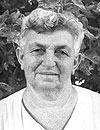
|
Miriam Baratz
-
Born on December 23, 1889
-
Made aliyah on September 12, 1906
-
Arrived at Umm Juni in 1910
-
Moved to the permanent settlement on October 28, 1910
-
Died on December 30, 1970 |
 |
Miriam was born in Bogoslav in the Ukraine, a small town whose population consisted mainly of Jews. In the house of her father, Reb Yosef Leib Ostrovsky, there prevailed an atmosphere of genuine Zionism. There were six children in the family. They were not wealthy but they were open and generous and in their home there could always be found guests and people in need. From her childhood days Miriam had heard about Eretz-Yisrael (The Land of Israel), about buying land and about the community in the country.
Under the influence of her brother Aharon, who had made aliyah, her father, Yosef Leib, arrived in Israel in 1905 and bought a 10 dunam parcel of land in Kfar Saba. After that he returned to Russia in order to bring the rest of the family. Miriam arrived in Eretz-Yisrael in 1906, having not yet reached the age of 17. Full of energy and enthusiasm, she found work in Jaffa; from there she moved to Kfar Saba and managed a restaurant that her grandfather had opened. After that she went to Petach-Tikva, found work in the orchards and was independent. The farmer Yaakov Kroll, from Petach-Tikva, who advocated ‘Hebrew work’, saw her and invited her to work in his citrus grove. At this time a group of friends arrived in the Kinneret Yard. They moved into the ancient abandoned house of the Khan, which stood at the top of the hill. In spite of the difficult conditions they decided to remain at the place. Sarah Malkin managed domestic matters there; when she fell ill they wrote to Miriam and asked her to come and take Sarah’s place. So Miriam set out for the Kinneret Yard, stayed there for some months and worked at cooking, cleaning and sewing. From Kinneret she went to Mitzpe and from there to Hedera, where she worked in agriculture. The first workers of the Kinneret Yard also arrived there – the members of the Romanian Commune. When the question of Umm Juni arose it was suggested to the members of the commune that they accept the farm from a group which had been at the place the previous year and were about to disband. So they went to Umm Juni and Miriam was with them. At that time her father summoned her to return to Russia, which she did, and he urged her to remain. After much dispute she returned to Eretz-Yisrael.
At that time the first cow was bRought at Umm Juni; it was bought down from the mountains of the Golan. When Miriam returned from visiting she wanted to learn to milk but most of the members were opposed to the idea. She approached the wife of the sheikh who lived nearby and asked her to teach her how to milk. They would go to the cowsheds to milk the cows during the night. So Miriam learned how to milk and she went about setting up a cowshed. The cowshed she set up gradually expanded and it supplied the members of Degania with milk and dairy products. In the month of Sivan (June) 1912, when Degania was a year old, the members moved from Umm Juni to permanent houses at its present place and they celebrated the harvest season and the wedding of Joseph and Miriam.
After their first two children, Gideon and Dvora were born, Miriam went to Ben Shemen with them, for training in working with cows and she remained there (as though on principle) and she set up a large and exemplary cowshed. After Miriam was compelled to leave the cowshed, for reasons of age and health, she continued working in the kitchen, in preparing the cooking, until her last day. On the last day, she lay down to rest – and didn’t get up. She was 81.
Miriam was a familiar figure among the general public and she represented Degania at home and abroad. She was also active in women’s organizations and she became a symbol of the working woman, a pioneer in the land of Israel. She left an extended family; seven children – Gideon, Dvorka, Amos, Yoya, Baia, Michal and Eli, and their families, grandchildren and greatgrandchildren.
May her memory be for a blessing.
 |

